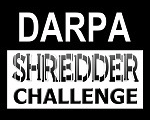No Chance of Destroying the Evidence with DARPA’s Shredder Challenge
Published Jan-23-12Breakthrough:
An exhilarating race to solve one of the world’s toughest puzzles and help the US military reconstruct shredded documents.
Company:
DARPA, United States
The Story:
 The scene is a familiar one: a regime on the run shreds all its top secret documents and leaves precious little behind for incoming forces to find. That’s a scenario that provided inspiration for an intriguing open innovation challenge from the Defense Advanced Research Project Agency (DARPA).
The scene is a familiar one: a regime on the run shreds all its top secret documents and leaves precious little behind for incoming forces to find. That’s a scenario that provided inspiration for an intriguing open innovation challenge from the Defense Advanced Research Project Agency (DARPA). A Puzzle of Many Pieces
Its Shredder Challenge asked participants to create a system for reconstructing shredded papers and then to demonstrate it by reassembling five shredded documents of increasing difficulty, from 224 pieces to over six thousand. Solving jigsaws was child’s play by comparison.
The contest’s aims were two-fold: 1) to develop ways of reconstructing shredded documents left behind by enemies in war zones 2) identify how shredded US documents could be read, so that effective countermeasures can be created.
The competition opened in October 2011 with a deadline of December the 4th, and nearly 9,000 potential solvers took up the call and responded with solutions.
The pieces of the puzzles were all available for download from DARPA’s website.
The winner was a small three person team of programmers from San Francisco called “All Your Shreds Belong to U.S.” It took them 600 hours to create their custom-made computer vision algorithms and work on the shredded documents. Their algorithms automatically suggested matching pieces of fragmented documents based on a number of factors such as the shape of the rips or marks on the paper. Then they asked friends to put together the pieces by hand.
The team solved the puzzles and put the documents back together again in just 33 days. For their efforts they walked away with the $50,000 prize.
According to the contest organisers the most effective approaches that participants tried were a combination of computational tools, crowdsourcing and detective work. Given the difficult nature of the challenge they were pleasantly surprised that it was solved in such a relatively short time frame.
“Lots of experts were sceptical that a solution could be produced at all let alone within the short time frame,” said Dan Kaufman, director, DARPA Information Innovation Office. “The most effective approaches were not purely computational or crowd-sourced, but used a combination blended with some clever detective work.”
Your Country Needs Your Smarts
This contest is one of a number open innovation approaches employed by the military’s way out research arm. Other DARPA-led efforts that have harnessed the smart brains of civilians include the Grand Challenge for driver-less vehicles and the Red Balloon Hunt.
In addition, the Obama administration has created the challenge.gov website where agencies post challenges for people to solve for cash prizes. The government is wise to just how valuable the crowd can be.
Not only do these open innovation approaches yield a diverse mix of ideas that provide viable solutions, but they catalyse research into seemingly intractable problems.
These points were emphasised by DARPA Director, Regina E. Dugan: “The DARPA Shredder Challenge underscores the value of increasing the number and diversity of problem solvers. The varied methods used have potential implications for so-called 'wicked problems,' generally considered insolvable by conventional means, and offer the possibility of increased speed, agility and breadth in innovation.”
[DARPA SHREDDER CHALLENGE]
Next Story »
